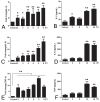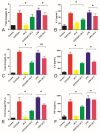Inhibitory Effects of Antimicrobial Peptide JH-3 on Salmonella enterica Serovar Typhimurium Strain CVCC541 Infection-Induced Inflammatory Cytokine Release and Apoptosis in RAW264.7 Cells
- PMID: 30736473
- PMCID: PMC6384860
- DOI: 10.3390/molecules24030596
Inhibitory Effects of Antimicrobial Peptide JH-3 on Salmonella enterica Serovar Typhimurium Strain CVCC541 Infection-Induced Inflammatory Cytokine Release and Apoptosis in RAW264.7 Cells
Abstract
The antibiotic resistance of Salmonella has become increasingly serious due to the increased use of antibiotics, and antimicrobial peptides have been considered as an ideal antibiotic alternative. Salmonella can induce macrophage apoptosis and thus further damage the immune system. The antimicrobial peptide JH-3 has been shown to have a satisfactory anti-Salmonella effect in previous research, but its mechanism of action remains unknown. In this study, the effects of JH-3 on macrophages infected with Salmonella Typhimurium CVCC541 were evaluated at the cellular level. The results showed that JH-3 significantly alleviated the damage to macrophages caused by S. Typhi infection, reduced the release of lactic dehydrogenase (LDH), and killed the bacteria in macrophages. In addition, JH-3 decreased the phosphorylation level of p65 and the expression and secretion of interleukin 2 (IL-2), IL-6, and tumor necrosis factor-α (TNF-α) by inhibiting the activation of the mitogen-activated protein kinase (MAPK) (p38) signaling pathway and alleviating the cellular inflammatory response. From confocal laser scanning microscopy and flow cytometry assays, JH-3 was observed to inhibit the release of cytochrome c in the cytoplasm; the expression of TNF-αR2, caspase-9, and caspase-8; to further weaken caspase-3 activation; and to reduce the S.-Typhi-induced apoptosis of macrophages. In summary, the mechanism by which JH-3 inhibits Salmonella infection was systematically explored at the cellular level, laying the foundation for the development and utilization of JH-3 as a therapeutic alternative to antibiotics.
Keywords: Salmonella; antimicrobial peptide JH-3; apoptosis; cytokines.
Conflict of interest statement
The authors declare no conflict of interest.
Figures








Similar articles
-
Antimicrobial Peptide JH-3 Effectively Kills Salmonella enterica Serovar Typhimurium Strain CVCC541 and Reduces Its Pathogenicity in Mice.Probiotics Antimicrob Proteins. 2019 Dec;11(4):1379-1390. doi: 10.1007/s12602-019-09533-w. Probiotics Antimicrob Proteins. 2019. PMID: 31001786
-
Baicalin inhibits Salmonella typhimurium-induced inflammation and mediates autophagy through TLR4/MAPK/NF-κB signalling pathway.Basic Clin Pharmacol Toxicol. 2021 Feb;128(2):241-255. doi: 10.1111/bcpt.13497. Epub 2020 Oct 4. Basic Clin Pharmacol Toxicol. 2021. PMID: 32955161
-
Glycyrrhizin Attenuates Salmonella enterica Serovar Typhimurium Infection: New Insights Into Its Protective Mechanism.Front Immunol. 2018 Oct 16;9:2321. doi: 10.3389/fimmu.2018.02321. eCollection 2018. Front Immunol. 2018. PMID: 30459751 Free PMC article.
-
Salmonella-induced macrophage death: the role of caspase-1 in death and inflammation.Microbes Infect. 2001 Nov-Dec;3(14-15):1201-12. doi: 10.1016/s1286-4579(01)01480-0. Microbes Infect. 2001. PMID: 11755408 Review.
-
Type 1 interferon-associated necroptosis: a novel mechanism for Salmonella enterica Typhimurium to induce macrophage death.Cell Mol Immunol. 2013 Jan;10(1):10-2. doi: 10.1038/cmi.2012.54. Epub 2012 Nov 12. Cell Mol Immunol. 2013. PMID: 23147719 Free PMC article. Review. No abstract available.
Cited by
-
Evaluation of the efficacy of the antimicrobial peptide HJH-3 in chickens infected with Salmonella Pullorum.Front Microbiol. 2023 Jan 24;14:1102789. doi: 10.3389/fmicb.2023.1102789. eCollection 2023. Front Microbiol. 2023. PMID: 36760504 Free PMC article.
-
The Antimicrobial Peptide Mastoparan X Protects Against Enterohemorrhagic Escherichia coli O157:H7 Infection, Inhibits Inflammation, and Enhances the Intestinal Epithelial Barrier.Front Microbiol. 2021 Jun 10;12:644887. doi: 10.3389/fmicb.2021.644887. eCollection 2021. Front Microbiol. 2021. PMID: 34177825 Free PMC article.
-
Antimicrobial peptides´ immune modulation role in intracellular bacterial infection.Front Immunol. 2023 Mar 28;14:1119574. doi: 10.3389/fimmu.2023.1119574. eCollection 2023. Front Immunol. 2023. PMID: 37056758 Free PMC article. Review.
-
Antibacterial mechanism analysis of resveratrol against Salmonella typhimurium via metabolomics.Appl Microbiol Biotechnol. 2024 Nov 12;108(1):512. doi: 10.1007/s00253-024-13341-w. Appl Microbiol Biotechnol. 2024. PMID: 39531061 Free PMC article.
-
Salmonella Virulence and Immune Escape.Microorganisms. 2020 Mar 13;8(3):407. doi: 10.3390/microorganisms8030407. Microorganisms. 2020. PMID: 32183199 Free PMC article. Review.
References
-
- Majowicz S.E., Musto J., Scallan E., Angulo F.J., Kirk M., O’Brien S.J., Jones T.F., Fazil A., Hoekstra R.M. The Global Burden of Nontyphoidal Salmonella Gastroenteritis. J. Food Saf. 2010;6:882–889. - PubMed
-
- Thomas M., Fenske G.J., Antony L., Ghimire S., Welsh R., Ramachandran A., Scaria J. Whole genome sequencing-based detection of antimicrobial resistance and virulence in non-typhoidal Salmonella enterica isolated from wildlife. Gut Pathog. 2017;1:66. doi: 10.1186/s13099-017-0213-x. - DOI - PMC - PubMed
-
- Bai L., Lan R., Zhang X., Cui S., Xu J., Guo Y., Li F., Zhang D. Prevalence of Salmonella Isolates from Chicken and Pig Slaughterhouses and Emergence of Ciprofloxacin and Cefotaxime Co-Resistant S. enterica Serovar Indiana in Henan, China. PLoS ONE. 2015;10:e014453212. doi: 10.1371/journal.pone.0144532. - DOI - PMC - PubMed
-
- El-Sharkawy H., Tahoun A., El-Gohary A.E.A., El-Abasy M., El-Khayat F., Gillespie T., Kitade Y., Hafez H.M., Neubauer H., El-Adawy H. Epidemiological, molecular characterization and antibiotic resistance of Salmonella enterica serovars isolated from chicken farms in Egypt. Gut Pathog. 2017;9:8. doi: 10.1186/s13099-017-0157-1. - DOI - PMC - PubMed
-
- Flores- Alvarez L.J., Guzmán- Rodríguez J.J., López- Gómez R., Salgado- Garciglia R., Ochoa- Zarzosa A., López- Meza J.E. PaDef defensin from avocado (Persea americana var. drymifolia) is cytotoxic to K562 chronic myeloid leukemia cells through extrinsic apoptosis. Int. J. Biochem. Cell Biol. 2018;99:10–18. doi: 10.1016/j.biocel.2018.03.013. - DOI - PubMed
MeSH terms
Substances
Grants and funding
- 31702259 and 31672559/National Natural Science Foundation of China/International
- 2016YFD0500708-04/National Key Research and Development Program of China/International
- 174100510005/the Excellent Youth Foundation of Henan Scientific Committee/International
- 14HASTIT026/the Program for Science Technology Innovation Talents in Universities of Henan Province/International
LinkOut - more resources
Full Text Sources
Research Materials

